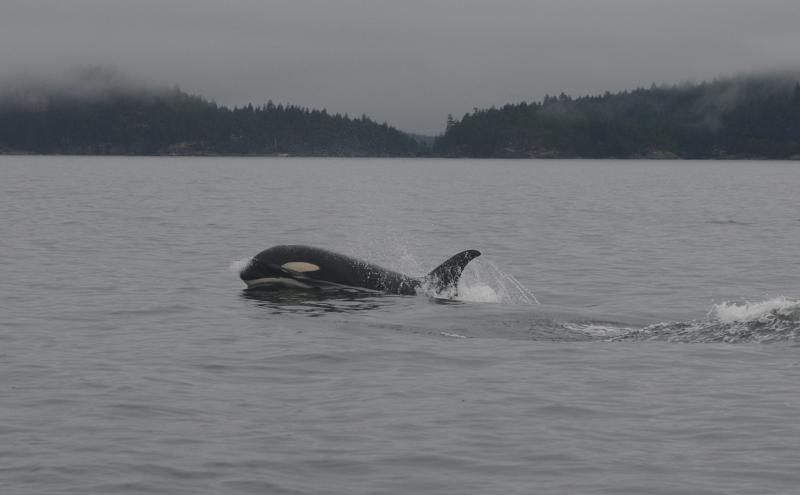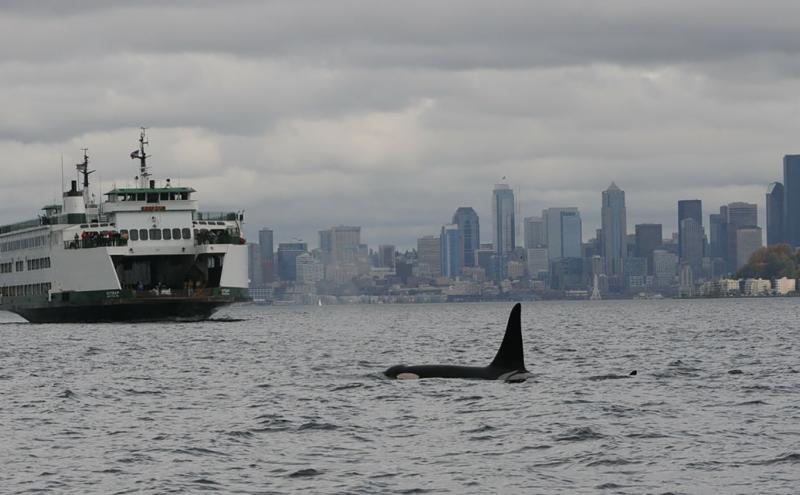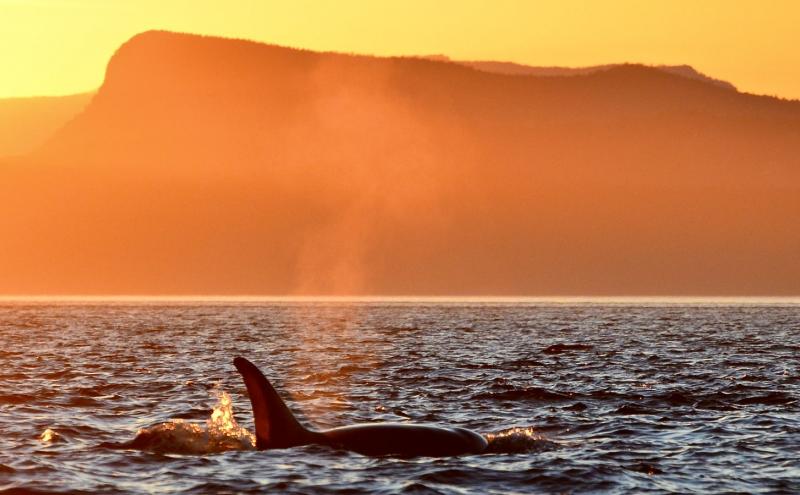
By Danielle Butsick, Senior Environmental Management Specialist, Port of Seattle
Protecting the critically endangered Southern Resident killer whales in Puget Sound is a top priority for the Port of Seattle and its partners from across the region. Underwater noise, which comes from many sources, including in-water construction, vessel traffic, and shoreside operations is a threat to the health of these iconic marine mammals, a species ecologically, economically, and culturally important to our region. The noise from these activities can interfere with the Southern Resident killer whale’s ability to communicate with one another and increases difficulty for the social animals to find mates and hunt for food.
To address these threats, the Port of Seattle and partners from across Puget Sound and the Salish Sea are conducting research and leveraging technology to better understand and reduce acoustic impacts to Southern Resident killer whales and other imperiled mammalian species.
Port Commissioners authorized investments in underwater noise research, exploration of potential benefits of new noise-reducing technologies, use of “best management practices”, and strategic planning to understand more ways to reduce impacts of maritime-related activities.
"By leveraging research and technology, the Port and our partners can apply lessons learned from around the world to reduce underwater noise and protect the critically endangered Southern Resident killer whales that are so iconic to our region," said Port Commissioner Fred Felleman, who conducted his graduate research on this whale population. "I’m committed to supporting these efforts to help ensure that commerce and communities can co-exist in these waters.”
Learn about these important Port investments to help quiet the Sound and waterways and reduce impacts on marine life.
Construction technologies
Double-wall piling pilot study
In 2021, Port contractors installed a piling-supported public access pier at Duwamish River People’s Park. Marine pile driving, which is used to install a deep foundation in water, produces high sound pressure levels in both the surrounding air and underwater environment. The Port saw an opportunity to test out a new type of double-walled piling in the construction of the pier, designed to reduce the spread of noise underwater.
The Port worked with the piling manufacturer to fabricate steel pilings for the project, and conducted underwater noise, in-air noise, and ground-vibration monitoring to assess how well the pilings worked to reduce noise during installation. Data collected as part of this project provided valuable information to improve the technology and understand how it works in different environments and will be used to inform recommendations for potential future use of the technology.
Custom “bubble curtain” for Terminal 5 construction
The Port’s Terminal 5 Rehabilitation and Berth Deepening project invests over $300 million in infrastructure improvements to grow international marine cargo transportation. The facility is under construction now; phase 1 is complete and phase 2 construction continues through 2022.
The scale of the project and the amount of pile driving needed to reconstruct the north vessel berth meant that extra protections were needed to ensure construction activities were not negatively affecting marine mammals and other protected species.
“Bubble curtains” are often used to absorb noise from in-water construction activities reducing the distance it travels underwater. Rings of bubbles are released continuously during in-water construction activities and essentially “cancels out” noise that can harm marine life. However, they aren’t typically used for the scale of construction happening at Terminal 5.
So, the Port collaborated with underwater noise experts at Washington State Department of Transportation, and a leading underwater noise consulting firm, JASCO, to design two 83-foot-long custom bubble curtains. This equipment meets the needs of the project and ensures marine life would remain protected. We believe this is the largest bubble curtain ever fabricated! Subsequent underwater noise monitoring in the project vicinity showed that the device successfully decreased noise to the levels approved by the United States Fish and Wildlife Service (USFWS) and National Oceanic and Atmospheric Administration (NOAA), Fisheries Division.
Best management practices
Marine mammal monitoring
Whenever the Port does in-water construction projects that involve driving pilings with a vibratory hammer, one or more biologists are called in to monitor the area (depending on the scale of the activity). These biologists monitor the area for organisms (such as a Southern Resident killer whale) that would potentially be harmed by the underwater noise. If a protected species is observed, the marine mammal monitors — which are often stationed both in a small work boat and on shore — immediately call the construction crew to alert them to the sighting and stop work until the animal has left the area.
Strategic planning and research
Underwater Noise Mitigation and Management Plan
The Port is a member of Green Marine, a voluntary environmental certification program with members across the North American maritime industry, including Canada and the United States. Green Marine encourages its members to take measurable steps to reduce their environmental impact and invest in operational improvements to improve environmental outcomes. One of Green Marine’s certification criteria is Underwater Noise. The Port is currently certified at Level 2 status. To achieve Level 3, the Port is developing an Underwater Noise Mitigation and Management Plan (UNMMP) that will help chart a course for setting and achieving noise reduction targets.
The UNMMP will contain a summary of the potential impacts to protected species from underwater noise generated from Port-related activities, and will describe noise reduction and mitigation measures, as well as best management practices to minimize underwater noise. The plan will also describe a potential underwater noise monitoring strategy and data needed to better understand underwater noise generated by Port-related activities.
Hydrophone Gaps Analysis partnership with University of Washington Applied Physics Lab and NOAA
As part of its quest to better understand underwater noise in the Puget Sound and Salish Sea, especially related to large commercial vessels, the Port is partnering with the University of Washington Applied Physics Lab and NOAA Fisheries to study gaps in the hydrophone network — the technology used to monitor both vessels and marine mammals. Researchers will study the existing network to develop recommendations for how the technology can be better leveraged, and how to improve the way equipment works together and provides data to end users. With any funding left over from the study, the team will purchase hydrophones or install listening stations (per the study recommendations) to gather data on underwater noise from large commercial vessels.
Underwater “in-situ” dredge monitoring
A deeper berth was needed as part of the Terminal 5 Rehabilitation and Berth Deepening project to receive the large new modernized cargo vessels. This dredge project, in early January 2022, was a prime opportunity to document the types, frequencies, and amounts of noise generated during dredging activities — since very little data currently exists. The Port assembled and deployed a team of specially trained hydroacoustic technicians and equipment to monitor the construction activities in real-time. They collected underwater noise data before, during, and after the dredge operations, and at all different phases of the work to characterize the different sources of noise. Underwater noise levels during dredging operations at Terminal 5 were not measured to be considerably higher than background and were lower than all other observed noise sources.
Investing in Quiet Sound
Quiet Sound is a collaborative program officially launched in 2021, aimed at reducing underwater noise impacts to Southern Resident killer whales from large commercial vessels. The Port of Seattle is a founding member of Quiet Sound, and helped lead the planning team that defined the program’s mission and overall structure. Now that it is officially launched, under the operational leadership of Maritime Blue, the Port has committed financial support for Quiet Sound for the next three years, and Port staff will serve on the Leadership Committee to help guide operational decisions. Staff will also participate in three of the five Quiet Sound working groups established to undertake specific technical studies and work on targeted underwater noise reduction efforts. These groups include the Monitoring Whales and Vessel Noise work group, Vessel Operations and Incentives work group, and the Whale Notification System work group.
Top photo credit: "Southern resident killer whales" by NOAA Fisheries West Coast is licensed under CC BY-NC-ND 2.0.







